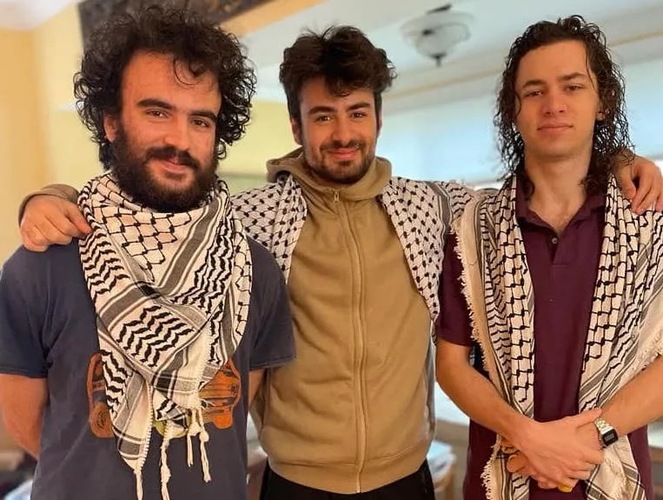Samia Abbass is a Palestinian American who lives in Brattleboro. She invites you to find out more about Palestinian food and culture, including the keffiyeh, at a tabling event at the Brattleboro Food Co-op later in December, on a date to be determined.
As a Palestinian American, some of my earliest memories involve the black-and-white Palestinian scarves called keffiyehs.
My sister and I were photographed in them as babies. They covered our strollers in rallies and protests before we could even say the word "Palestine." We tied them around our hips and shoulders as we played the make-believe belly dancers or Arabian princesses that we later came to recognize as exotified, Hollywood versions of our culture.
As I got older and traveled to places like Northern Ireland, Ecuador, and Nepal, I saw keffiyehs held up as global symbols of liberation and solidarity with oppressed people. They appeared in struggles for freedom around world, from the Indigenous people of South America to urban Black Lives Matter protesters in the United States - all connected ideologically to the Palestinian resistance movement.
* * *
The traditional square black-and-white cotton scarf is a powerful icon rooted in Palestinians' connection to our land. The scarves are embroidered with three patterns: waves to represent fishing nets and Palestinians' connection to the Mediterranean Sea; a leaflike line pattern for olive trees, a staple crop of Palestine and a symbol of Palestinian resilience; and a border of bold lines denoting the historical trade routes that passed through this region of the world.
Originally worn by nomadic Bedouin as protection from the elements, keffiyehs were also a way for them to differentiate themselves from fellahin (villagers or peasants), according to Wafa Ghnaim, a Palestinian expert on Palestinian embroidery (tatreez) and traditional Palestinian dress.
The scarf emerged as a political statement with the 1936 revolt against British colonial rule when Palestinian resistance fighters used keffiyehs to hide their faces. In the 1960s, the keffiyeh's power and symbolism were reinforced as a tool of the Palestinian nationalist movement worn by freedom fighters like Leila Khaled and Palestine Liberation Organization Chairman Yasser Arafat.
In the 1980s and 1990s, under Israeli military law during the first Palestinian intifada (which means "shaking off"), Israel made it illegal for anyone in the occupied Palestinian territories to cover their faces with a keffiyeh.
As such, these simple cotton scarves represent not only our struggle for freedom, they are also a powerful representation of Palestinian heritage and culture, which Israel continues to try to erase by killing the journalists and librarians who narrate our stories, by arresting theater workers, by destroying our books and museums, and by outlawing even basic human expressions like Palestinian joy at the release of our prisoners.
Today, with the help of global capitalism, keffiyehs have entered the mainstream fashion market, bedecking runway models and incorporated into major fashion brands. So, when I see someone wrapped in a keffiyeh on the subway or walking down the street, I always wonder, Do you know what you're wearing? Do you know what it means?
* * *
As Israel carries out its brutal war against Palestinians in Gaza and the West Bank, the Palestinian solidarity movement has once again been pushed to the center of the world stage.
Hirbawi, the sole remaining factory that makes keffiyehs in the West Bank, has been sold out for months. Meanwhile, I've seen more keffiyehs in the United States than perhaps any other time in my life - including here in Brattleboro. I've also gotten a lot of questions from people about whether it's OK for those who are not Palestinian to wear them.
From my perspective, as one Palestinian person, my answer to the question is: Wear the keffiyeh with pride if you know what it means, what it stands for, and what you stand for when you put it on.
Remember that the keffiyeh is rooted in resistance, both armed and nonviolent, because that is part of the history and struggle of Palestine in the face of occupation and apartheid.
Remember that the keffiyeh refers to the symbols, beliefs, and stories associated with a Palestinian culture - our music, language, dance, symbols, and food - which is being actively erased and co-opted.
Wear the keffiyeh if you stand for resistance against oppression, the yearning for freedom, the deep roots of Indigenous struggle for liberation that lives within Palestinian heritage and is central to our identity as a people.
Recognize that your calls must extend beyond a ceasefire to demands for an end to the occupation and freedom with justice for Palestinians. Anything less silences and marginalizes our history and our context within larger themes of structural violence, colonialism, and imperialism.
So wear the keffiyah! Wear it in solidarity. Wear it with pride. Wear it with knowledge.
This Voices Viewpoint was submitted to The Commons.
